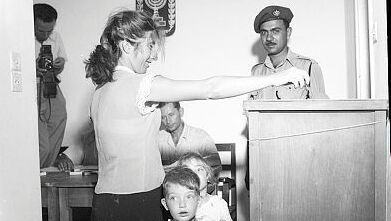
Rivalry and tension between the defense minister and the prime minister, party splits, and a feeling that “the election boiler has reached a boiling point, and its buzz is heard all over the country.” Although it sounds like a description of the current election, these were the headlines in the July 1955 election campaign. Ynet and the National Library continue their historic journey between the Israeli election campaigns.
11 View the gallery
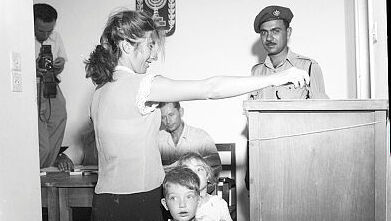

Voting at the ballot box, 1955
(Photo: David Rubinger)
11 View the gallery


At the center of the election campaign for the Third Knesset was the return of the first prime minister, David Ben-Gurion, to political life, after he retired to Sde Boker in 1953. Even when he was in his barracks in the Negev, he was still involved in various issues through his people and associates. For example, he continued to promote the policy of “retaliatory actions” together with the then chief of staff, Moshe Dayan, and behind the back of Prime Minister Moshe Sharett.
The “bad business” affair, in which Israeli spies were captured in Egypt and some of them were executed, led to the removal of Pinchas Lavon from the Ministry of Defense, and Ben-Gurion, who returned from the political time-out he took, took office.
11 View the gallery
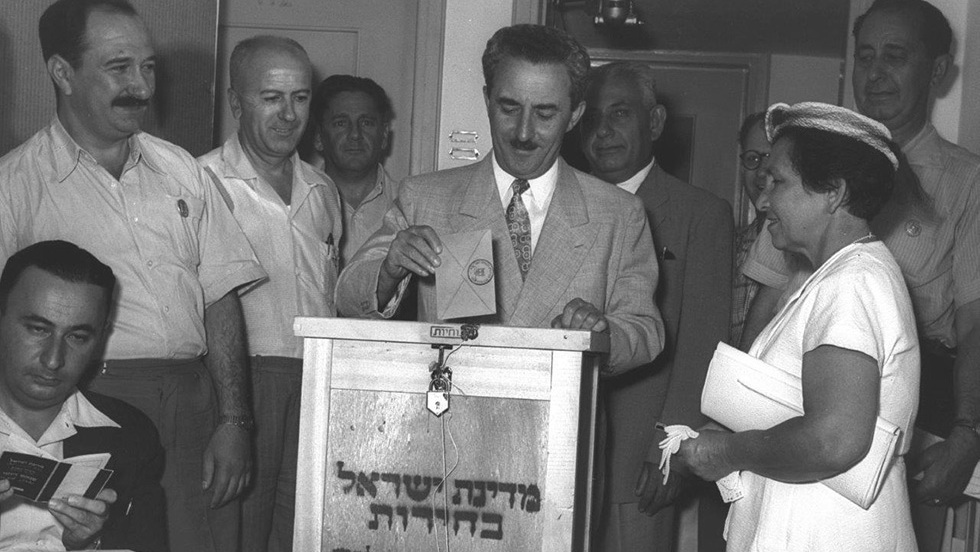

Server votes in the 1955 election
(Photo: Fritz Cohen)
11 View the gallery


Ben-Gurion at a Mapai election rally
(Photo: David Rubinger)
Upon his return to the political system, it was clear that Ben-Gurion would return to lead the country in the upcoming elections, and the tension between him and Sharett was felt. In fact, the government was conducted with two heads, with Ben-Gurion initiating and approving military operations across the border without the knowledge of Prime Minister Sharett.
But this was not the only issue that stirred the spirits ahead of the Knesset elections. A few weeks before the election itself, the verdict was given in Israel Kasztner’s defamation lawsuit against Malkiel Greenwald, a lawsuit that upset the Israeli public.
Kasztner was a member of the Budapest Aid and Rescue Committee during the Nazi occupation. He maintained contacts with the Nazis to save Jews, and among other things organized a train carrying 1,684 Jews that left Hungary and eventually reached Switzerland. After the war he testified in favor of Nazi defendants.
11 View the gallery
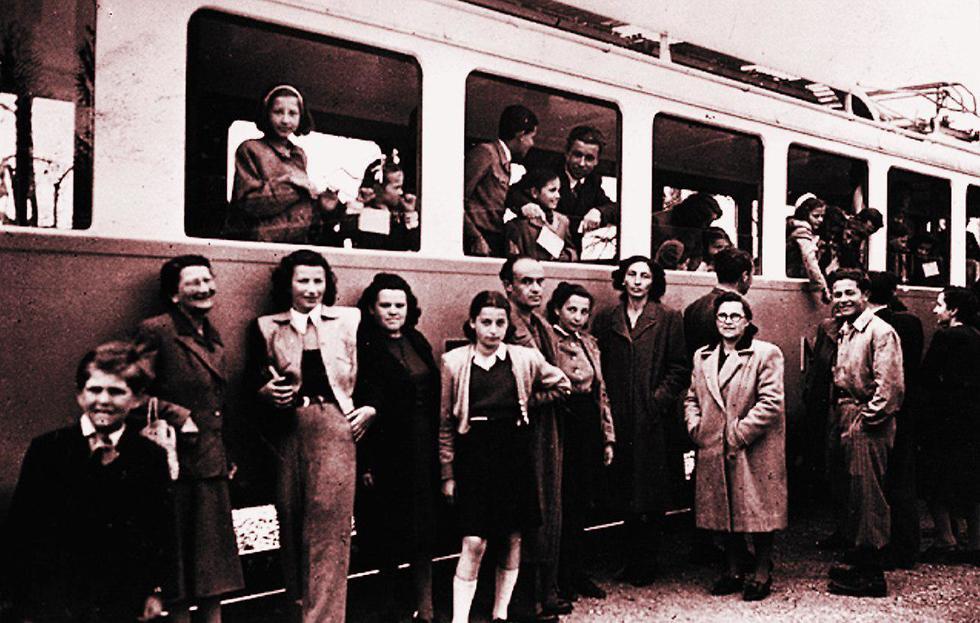

The train that Kasztner took out of Hungary
(Photo: Courtesy of Yad Vashem )
In 1947, Kasztner immigrated to Israel, and with the establishment of the state, he accepted a position in the Ministry of Trade and Industry and was even on the list of Mapai candidates in the Knesset elections.
In late 1952, journalist Malkiel Greenwald accused Kasztner of collaborating with the Nazis. Kasztner pressured that a defamation lawsuit be filed against Greenwald, but instead of the trial revolving around whether or not Greenwald issued a libel, the journalist’s attorney, Shmuel Tamir, managed to get the hearing to revolve around rescue efforts, Kasztner’s character and Mapai’s functioning.
11 View the gallery


Begin on an election tour of the Talpiot transit camp. The Freedom Party filed a motion of no confidence following the trial
(Photo: David Rubinger)
The trial claimed that Mapai had not done enough to save the Jews of Europe from the Nazis. The Freedom Party submitted a motion of no confidence in the government following the trial, in response to which Prime Minister Moshe Sharett announced his resignation – and the election campaign began.
In June 1955, Judge Benjamin Halevy said Kasztner “sold his soul to the devil” and ruled that he had collaborated with the Nazis, adding fuel to the election campaign. Kasztner appealed, but did not get to see his acquittal in court because he was murdered by three members of a right-wing underground in March 1957.

One of the issues at the center of the election campaign for the Third Knesset was the allegations against the corruption of the ruling party – Mapai. For 25 years, the party has held the leadership of the Jewish community in Eretz Israel, even before the state was established.
After the systems of life in the country became established and the years of distress of the beginning of the state passed, the voices that lamented the corruption in the Mapai government increased. Mapai’s centralized government did not give enough space to other groups in the population to manage state affairs.
11 View the gallery


Declaration of Liberty against Mapai
(From the collections of the National Library)
The officials, who were associated with Mapai activists, often acted out of party loyalty, with the good of the state and the party often interfering. The possibility of obtaining work, housing, promotion or status often depended on the party’s middle ranks, which also unquestionably controlled the Histadrut. Employee representative and also a formidable employer who ran his own economy.
The allegations of protectionism were sharply criticized by Mapai for its mismanagement of the government.
The most notable change in the 1955 election campaign was among Mapam, which was the main opposition factor to the great and veteran Mapai. The left wing maintained a socialist-Soviet ideological affinity, as well as the name Mapam. On the other hand, the activist wing returned to bear the name “Labor Unity”.
In the end, the two parties together received more seats than the number of seats that Mapam had in the second Knesset, but the members lost their status in the election campaign, in which the main battle was between Mapai and the General Zionists.

Yedioth Ahronoth reporters across the country reported widespread failures to open polling stations. In Tel Aviv, the polls opened up to an hour late due to “a delay in operating the buses and a shortage of taxis. Even at 07:00, some polling stations were closed because the chairmen or members of the polling committees did not arrive.”
11 View the gallery
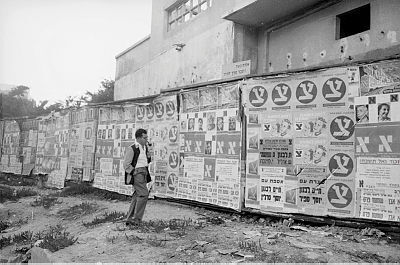

(Photo: David Rubinger)
About a hundred chairmen of the municipal election committees in Tel Aviv did not appear on the eve of the election in the offices of the election committee to receive the materials necessary to operate the polling station. Some of them claimed that they did not receive the delivery of the materials during the night and therefore the polling station could not be opened. But by 7:30 a.m., about an hour and a half from the official opening time, all the polling stations in the city were open.
In the Skia transit camp (now Or Yehuda), the opening of the polls was delayed because the Central Election Commission forgot to send the ballot stamp there. In Haifa, technical malfunctions were reported, such as the lack of equipment for observers on behalf of the parties with appropriate certificates.
11 View the gallery


Yedioth Ahronoth cover on Election Day
(From the Yedioth Ahronoth archive)
11 View the gallery
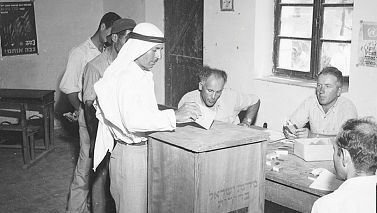

Vote in Abu Ghosh
(Photo: David Rubinger)
But in Haifa there were delays also because of the voters. At one polling station, voters refused to go in and vote because the ballot box was installed in front of an open window. Members of the Central Election Commission were called to the scene and ordered the window closed and sealed with thick paper.
In Jerusalem, some of the voters waited more than an hour and a half for the chairmen of the polling station to arrive and voting could begin. According to a report in Yedioth Ahronoth of the day, “great vigilance is felt in the neighborhoods inhabited by new immigrants, as well as in the ultra-Orthodox neighborhoods.
In Tel Aviv, it was reported that until 08:30, voting in the northern neighborhoods and in the heart of the city was “heavier” than in the southern neighborhoods. In one case, a couple was told to postpone their flight for a week, and outside the polling station a taxi was waiting for him at the airport.

Rehovot District Police Chief and MK Yizhar Smilansky competed for the title of “first voter on the streets,” but when they arrived at the unopened ballot box at 05:45, they discovered that the promotion was different. The first voter on the streets was Chaya Gordon, a 100-year-old woman.
In the Galilee localities, a large mobilization for a “transportation operation” was reported as early as 3:00 AM. While residents of some localities had to use donkeys to get to the polls or to pass on the results, party activists in the Safed area mobilized to transport voters to the polls, to make sure they did not waste any votes. “Strong reinforcements for the left-wing parties in the Galilee came in the form of vehicles from farms in the area that were mobilized to transport voters to the polls.”
11 View the gallery
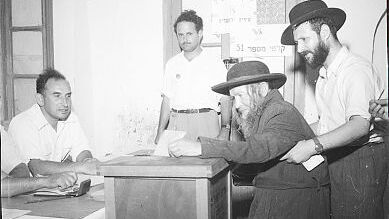

The polling station in Mea Shearim. It was initially placed in the church building and moved to a yeshiva
(Photo: David Rubinger)
The ballot box in the Mea Shearim neighborhood of Jerusalem was initially placed in the Romanian church building. “The ultra-Orthodox raised their fear of coming and voting in the church, so the ballot box was moved to the Chabad yeshiva building in the neighborhood. In the face of Naturi Karta’s propaganda, the rabbinical leadership largely supported the election. Rebbe Magor voted in Jerusalem, while Rebbe Moiznitz warned his followers.” Whoever did not go out to vote – not to come to the Rebbe’s table. “

19 lists ran in the 1959 election, but only 12 managed to enter the Third Knesset. Although Mapai lost five seats, it won the majority of votes and won the election with 40 seats.
Negotiations for the formation of the new government were extremely lengthy and lasted about three months. In November, Ben-Gurion presented his new government, which included Mapai, the national religious front (which changed its name to NRP – National Religious Party), Ahdut HaAvodah, Mapam and the Progressives.